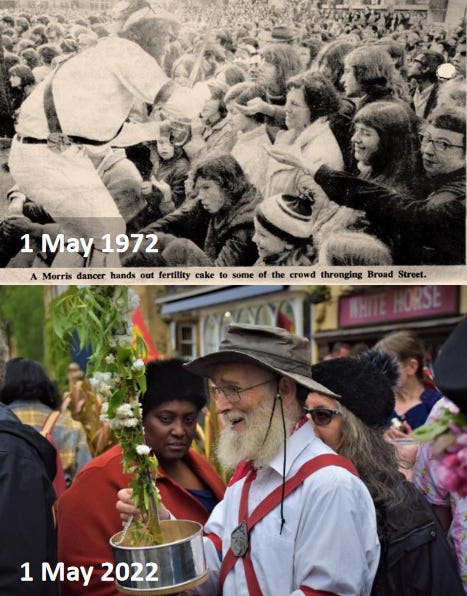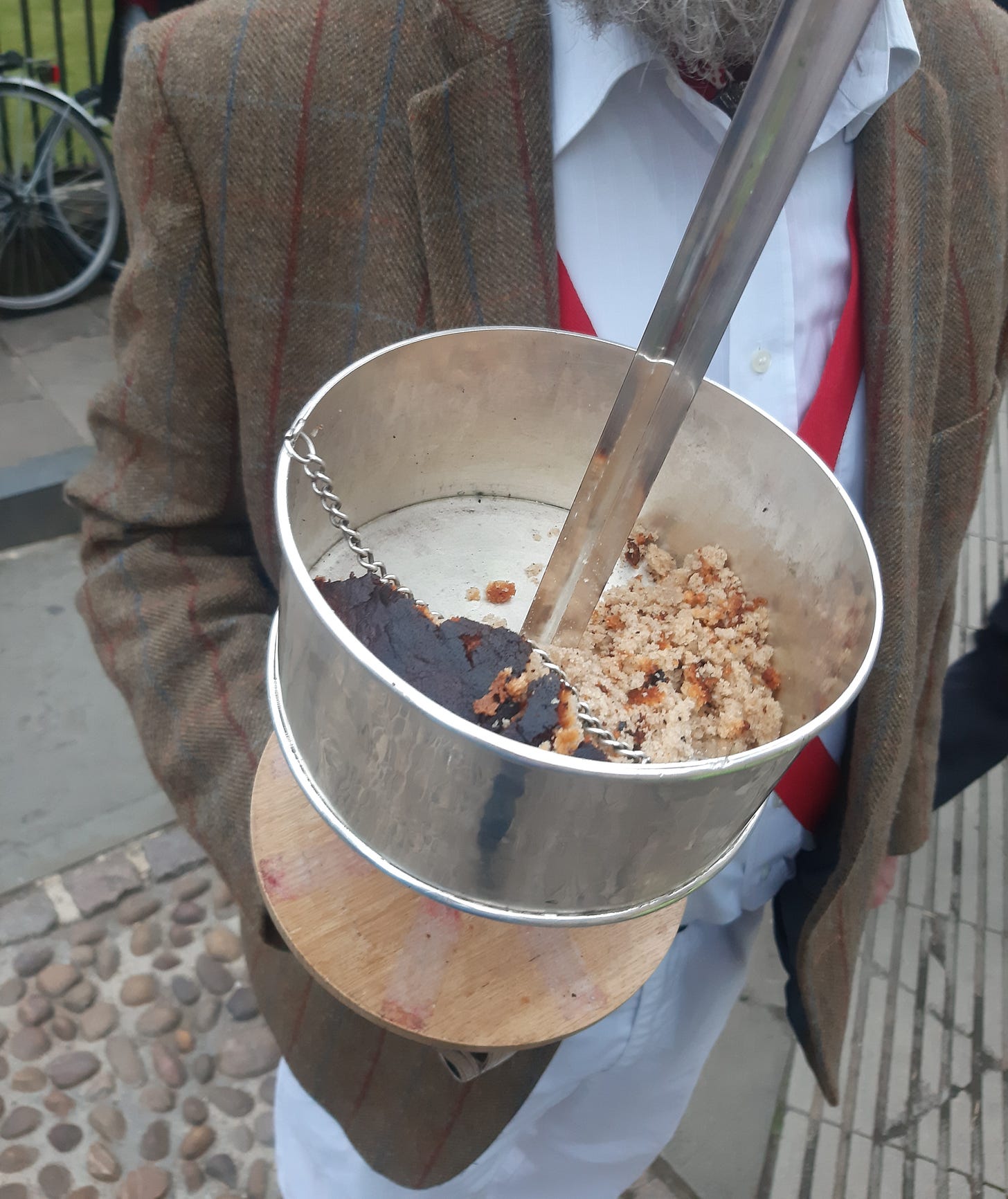On May day morning, the city of dreaming spires celebrated the arrival of spring, an age-old Celtic tradition with pagan roots, in its own unique way. Having evolved over many centuries in Oxford, this special morning of revelry retains a mystical quality enshrined and protected by those that came before, even offering the magic of fertility to those who seek it.
Since the early 16th Century, Magdalen College Choir ascend to the top of the Great Tower to sing the Latin hymn Hymnus Eucharisticus to the thousands of students and residents below on the High Street as they welcome the rising sun. This Oxford tradition is thought to have begun over five hundred years ago soon after the Great Tower was completed to bring the community together and mark the rebirth of spring and advent of longer, lighter days. For today’s community whether in their flower garlands or hoodies and trainers, this is a moment to listen enraptured to the choir, before the revelry begins: a procession of bands, the sight of the Jack-in-the-Green bobbing around - a person masquerading as a bush inside a wicker frame that dates from 1775– and the familiar sight of the ancient Morris men with their sticks, bells and handkerchiefs who have been dancing enthusiastically here for over a hundred years.
Photos from the booklet ‘100 Years of Morris Dancing’ produced by Oxford University Morris and Oxford City Morris
In amongst this scene of dancing, florals and foliage, is the sight of one of the ancient Morris men called the sword-bearer chosen specifically to bear a silver-plated copper sword with a cake impaled vertically on it. The sword and cake are said to symbolise both protection and fertility, and eating a small piece of this cake, made to a secret recipe, using one’s left hand and keeping one’s eyes closed, is thought to bring good luck and fertility. Bearing the inscription: ‘Theo Chaundy, Most Ancient Man, 1966’, the sword memorialises an important Oxford don and Morris dancer, Theo Chaundy, who was instrumental in the Oxford University Morris and their dancing being accepted by the University in 1926. The sword is part of a wonderful legacy but there’s more - by all accounts and anecdotes, this cake apparently wields magical properties that truly bear seed and fruit!
Being the custodian of the cake recipe is a serious matter as I discovered when I set up a call with Sally McCleery, the third-generation cake maker documented since 1966. The recipe is a closely guarded secret which involves not just the ritual of preparing it, but also the magical elements that are added. In addition, there’s anecdotal evidence that those who eat the cake actually fall pregnant: ‘My mother always told us not to eat the cake and the two occasions that my sisters did, they both fell pregnant. They both have two children.’
The making of the cake passing through the generations from Jill McCleery to her daughter, Sally McCleery
The first documented woman in Oxford to make the cake was the late Heather Lund whose husband, Peter, was one of the key early University Morris men – she clearly had the baking skills but also a mystical quality: ‘I remember, Heather,’ says Sally, ‘because they had this amazing house in Binsey, this incredible garden, and a gypsy caravan in the back garden. They had chickens everywhere and she used to be able to tell if an egg had a double yolk, so she'd always send us off with double yolk eggs, which was just magic as children’. Heather made the cake for thirty years, until Sally tells me, ‘she was frankly fed up’ and passed the honour on to Jill, Sally’s mother, who was renowned for her brilliant baking skills and that extra je-ne-sais-quoi that made her the perfect person: ‘I think my mum's got a bit of the witch about her, if it was four hundred years ago, she would probably have been burnt at the stake. She really does take the mysticism quite seriously.’ In recent years, as Jill’s health and memory has declined, Sally decided it was important to protect the recipe and they now make it annually together.
May preparations 2024: Sally McCleery with her mum, Jill, and her 6-year old niece who helps stir and then disappears for the magical part
A few days before May day, Sally and Jill gather to make the fertility cake that will then be distributed by an appointed sword bearer on May morning. The cake is made in a very specific sized tin that exactly fits the sword’s cake holder and is only used once a year for this purpose. A second back up cake is made to ensure stocks last for the eager revellers and is cut to fit the cake holder. So Sally, what about the secret recipe? ‘I mean the the cake in itself is a fairly standard recipe but it's what we add and it's how we prepare it that that kind of makes it what it is… I can’t tell you!’
‘Baking rituals’ are rarely discussed by the likes of Mary Berry, Ottolenghi, or Nigella who focus more on achieving a successful bake. From folkloric tradition, many white witches swear by a very simple age-old way to bring about magic, and although clearly conjecture, I’m left imagining Sally and Jill stirring clockwise over their cake cauldron whilst setting their intentions of good luck and fertility to all those who consume it. Perhaps there’s an incantation, music even, but their strength of focus and intent as they stir is what white witches claim invests the cake with powerful fertility forces. The cake recipe itself is described by Sally as ‘more standard than you might think’ but remains veiled in a web of secrecy. IVF nutrition manuals recommend fertility boosting and nutrient rich ingredients leading me to believe that the cake might be a banana, walnut, chocolate cake chosen for its hormone regulating bananas rich in B6 vitamins, walnuts bursting with magnesium to support progesterone and blood flow to the uterus, aphrodisiacal chocolate, some whole wheat flour and oats bursting with folate and zinc - particularly good for sperm. Or perhaps it is a simple pound cake finished with wildflowers symbolising rebirth?
Last year’s May Day I declined to taste a morsel of the cake as, with two children already and not wishing for more, I steered clear. Sally herself declines to eat it not wishing to tempt fate; after all the sword bearer bears no responsibility for unwanted pregnancies. This year my curiosity was too great and, to my husband’s horror, I guzzled up a crumb, while my teenage daughters looked on aghast, just to verify which of the potential recipes was correct. I can reveal that the ‘standard recipe’ definitely contains fertility boosting banana and overall is a pleasing, light sponge with buttery, sweet, floral overtones. I’m hoping such a tiny crumb doesn’t really count and won’t prove fatal to my family planning. Sally who by chance was there in my moment of madness reassured me: ‘it can just bring good luck’, begging the question, how much is enough?
With no hard stats, the fertility cake remains elusive but with magical possibilities. For anyone open to testing this further, the Spring Bank Holiday celebration in Bampton, Oxfordshire, on Monday 27th May 2024 serves up its own fertility cake. Track down the sword-bearer and follow the advice to pick up the fragment with your left hand, close your eyes, and let the magic takes its course.








This has me smiling broadly. Fond memories of May Day in Oxford. Was showing Vera the choir on Youtube. Love the narrative thread culminating with your girls on set and aghast! X
I'd never heard of this tradition until I read your post. Thank you for telling us about it.